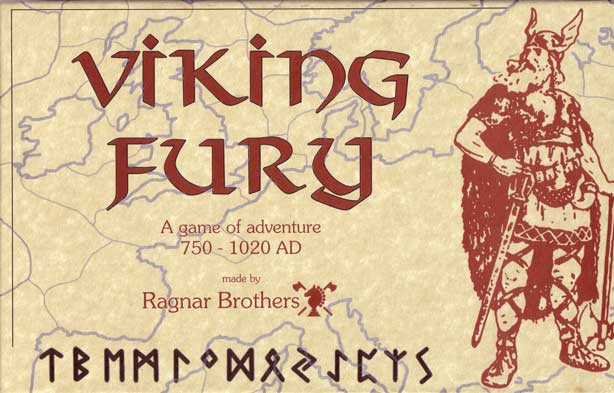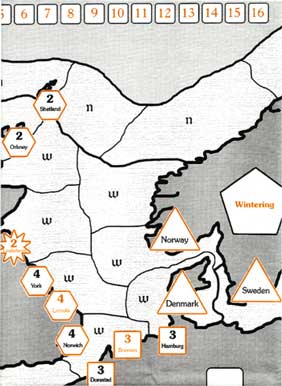Viking Fury is the latest game from UK designers The Ragnar Brothers best known for History of the World, which was picked up by Gibson's and then Avalon Hill. However, they have self-published plenty of other games, notably Backpacks & Blisters, a fun game of hiking around the Lake District. Given their name, it is perhaps surprising that they've taken so long to produce a Viking game. But here it is.  The first thing to note is that Viking Fury has the Ragnars' trademark printed 'tea towel' as a board. Tea towel is rather understating things as what we have here is a substantial cotton cloth that is A1 in size. Printed on it is a map of Europe. It looks a bit strange at first. This is because the important bits are not the land, but the seas and waterways across which the players travel on their expeditions. Like the Vikings themselves, the players are looking to trade, raid and settle across Europe. You do this by moving your longship marker from the Viking bases in Denmark, Norway and Sweden across the map. You each have a card that shows what you have on board your longship: men and goods. When you get to a coastal town, you can sell some of your cargo to gain victory points marked on a track round the board. Trading is also something of a Trojan horse. Each town has a value, which is the number of points you score for trading with it. It's also the town's resistance to being raided or settled. However, once a town has been traded with by any player its resistance is reduced by one. So you follow Viking tradition. Turn up as a peaceful trader with a load of furs, case the joint and come back later for a spot of looting. However, you can only raid towns that have treasures, like Lindisfarne and Lincoln. If you're successful, treasures score victory points, too more than trading with a town, on average. Though you don't know just how many until you get your hands on it. There are three big treasures in Paris, Rome and Constantinople. These are the three toughest towns to take on. And Rome and Constantinople are difficult to get to when you're based in Scandinavia. There's also a hefty bonus for whoever has the most treasures at the end. The mechanics of raiding mean that you have to risk men from your longship and may lose them. The same is true of settling. Here you will also have to use one of your pieces to establish the settlement, if successful. Unlike raiding and trading, settling only scores points at the end of the game. What's more, the more towns in a region (groups of three towns in the same area, such as Norwich, Lincoln and York on the east coast of Britain) that are settled, the more points each of them is worth. The way this works out is that raiding and trading are preliminaries. Both activities score points, but the big points come from colonies. The rules mean that players raid and trade before they settle, neatly reproducing history. The higher value towns are the most attractive, too, which focuses attention. What really drives the game, though, is carrying out the Sagas. Sagas are represented by a deck of cards; with each Saga allocated to Denmark, Norway or Sweden. Each card is awarded to the player who completes what is on it. It may be raiding particular towns, trading with a region or settling in a region. Some Sagas award extra victory points usually for the more difficult challenges, such as settling Newfoundland. At the end of the game, there is a substantial bonus for the players who hold the most Sagas for each of the three Viking nations. As a result, players tend to go for carrying out the Sagas. You can go and trade with the French towns if you want to, but you're better off doing this when there's a Saga to be collected. However, only two-thirds of the Saga cards are used in each game, so you can't be certain just what Sagas are going to come out. You also have to be the player who completes the Saga. It's worth looking out for opportunities to complete Sagas that others have started. The corollary is to beware of starting things you can't finish and leaving opportunities for others. So there's a premium on planning your expeditions. You have a limited number of 'actions' each turn. And you can only do one thing in each port. So look at what you can achieve in your turn to score points without leaving openings for others. The other element in the game is the deck of Rune cards. Players have up to three of these and can only gain more in home ports (Denmark, Norway and Sweden). Playing one lets you do something outside the normal rules. For example, moving somebody else's longship out of the way. Or trying to take over someone else's settlement the only way players can directly 'fight' each other. As you can see, these can be very useful for getting a tactical advantage.
Getting home is much easier. If you lose all your men, your turn ends and your longship is immediately returned to Scandinavia ("Wintering"). You can also choose to use this 'teleport' facility though you'll lose anything more than one crewman from your longship. Obviously, this ends your current expedition, but it sets you up to re-stock your longship and embark on the next. Okay, it's not particularly realistic, but it does make sure the game moves along. And it means you can plan expeditions tactically: put just what you need on board and go for it! So what we've got here is a very tactical game. The broad shape is obvious: trade first, then raid and finally settle. Given the bonuses available, it makes sense to take advantage of the Saga cards. So where you trade, raid or settle will be guided by the Sagas. And what the other players are up to. The Rune cards can give you ways of pulling a fast one and gaining an advantage over your opponents. Some of these can be quite powerful, especially towards the end of the game when there's limited time for your opponents to come back at you. While everybody will be picking up points during the game, the points for settlements at the end of the game are crucial. So you need to keep an eye on who's got what settlements to have an idea of who's doing well. However, there are also the bonuses for the Saga cards. Because these are scored separately for each nation, they're rather more difficult to work out. So you may have an idea how everybody else is doing, but you can't be certain. The result is an entertaining and highly competitive game. I recommend it.
Viking Fury was designed and published by the Ragnar Brothers. It is a tactical board game for 3-5 players, aged 12+ and takes about two hours to play. It is available in most specialist shops in the UK (at around £30) and some in the US (around $50). Alternatively, it can be ordered direct from the Ragnar Brothers.
Page created 14th October 2004. Last modified 19th May 2014. This website produced by Paul Evans. © Copyright Paul Evans 2004-2014. All trademarks acknowledged. Problems, comments and feedback to the Webmaster. |
Pevans |
 I haven't gone into the way ships move about the board. The seas and waterways are divided into four regions: north, south, east and west. Each region allows a different number of sailing 'days', restricting how far players can move in one turn (unless you throw things overboard). Thus the standard in the balmy Mediterranean is 6, while the inclement Arctic Ocean only allows 3. This is modified by the wind dial, which can be changed when you play a Rune card. Sometimes it's worth playing a Rune card just to modify the wind.
I haven't gone into the way ships move about the board. The seas and waterways are divided into four regions: north, south, east and west. Each region allows a different number of sailing 'days', restricting how far players can move in one turn (unless you throw things overboard). Thus the standard in the balmy Mediterranean is 6, while the inclement Arctic Ocean only allows 3. This is modified by the wind dial, which can be changed when you play a Rune card. Sometimes it's worth playing a Rune card just to modify the wind.